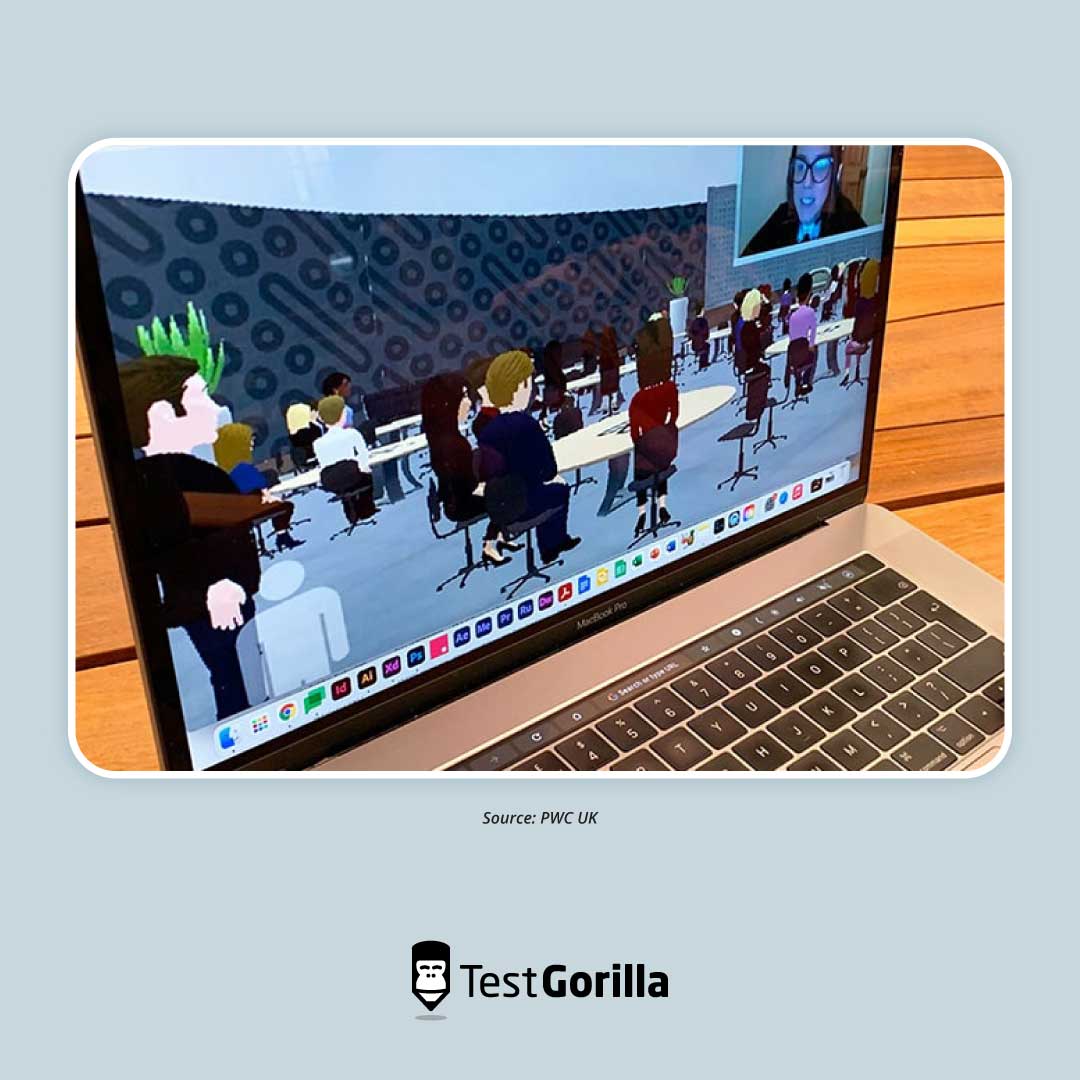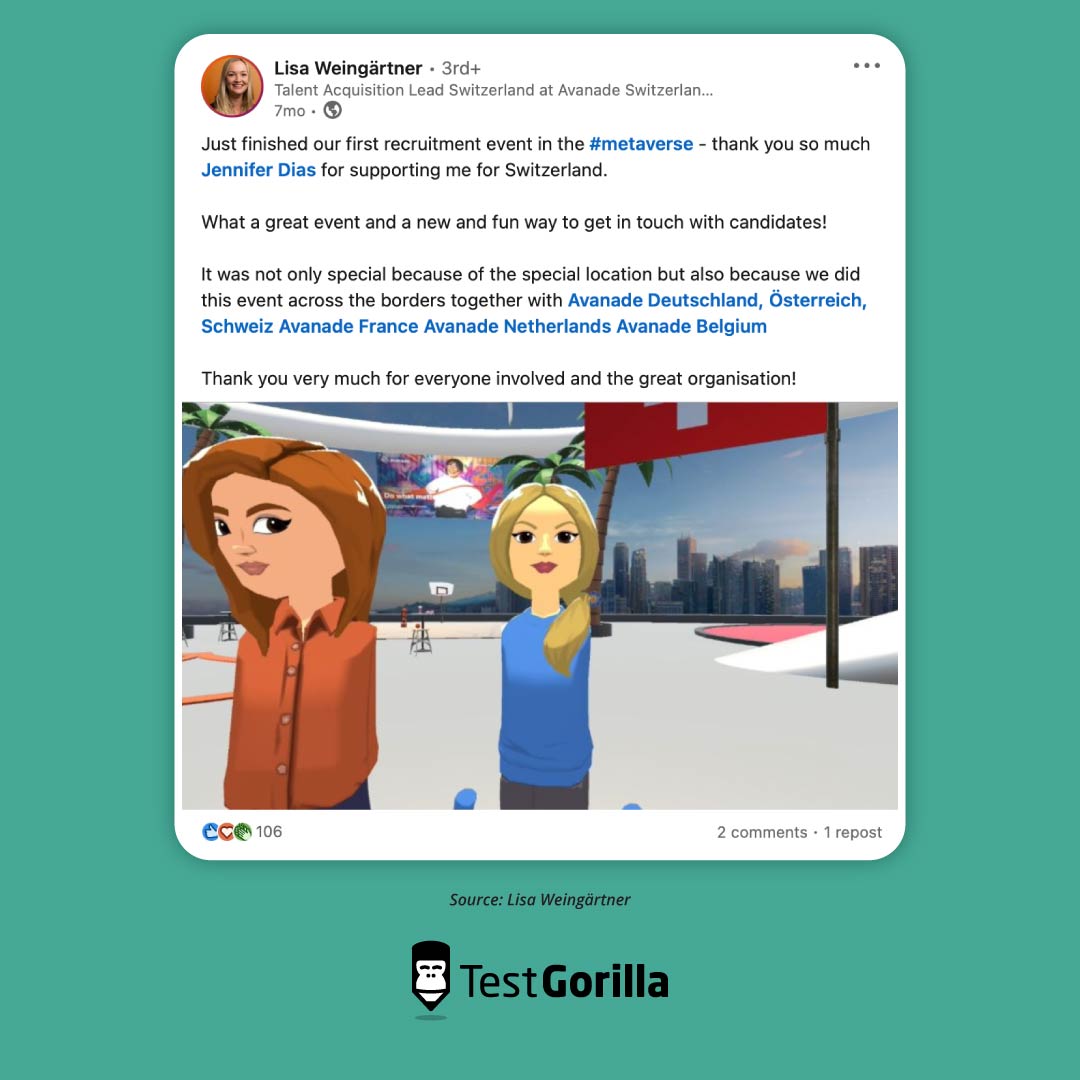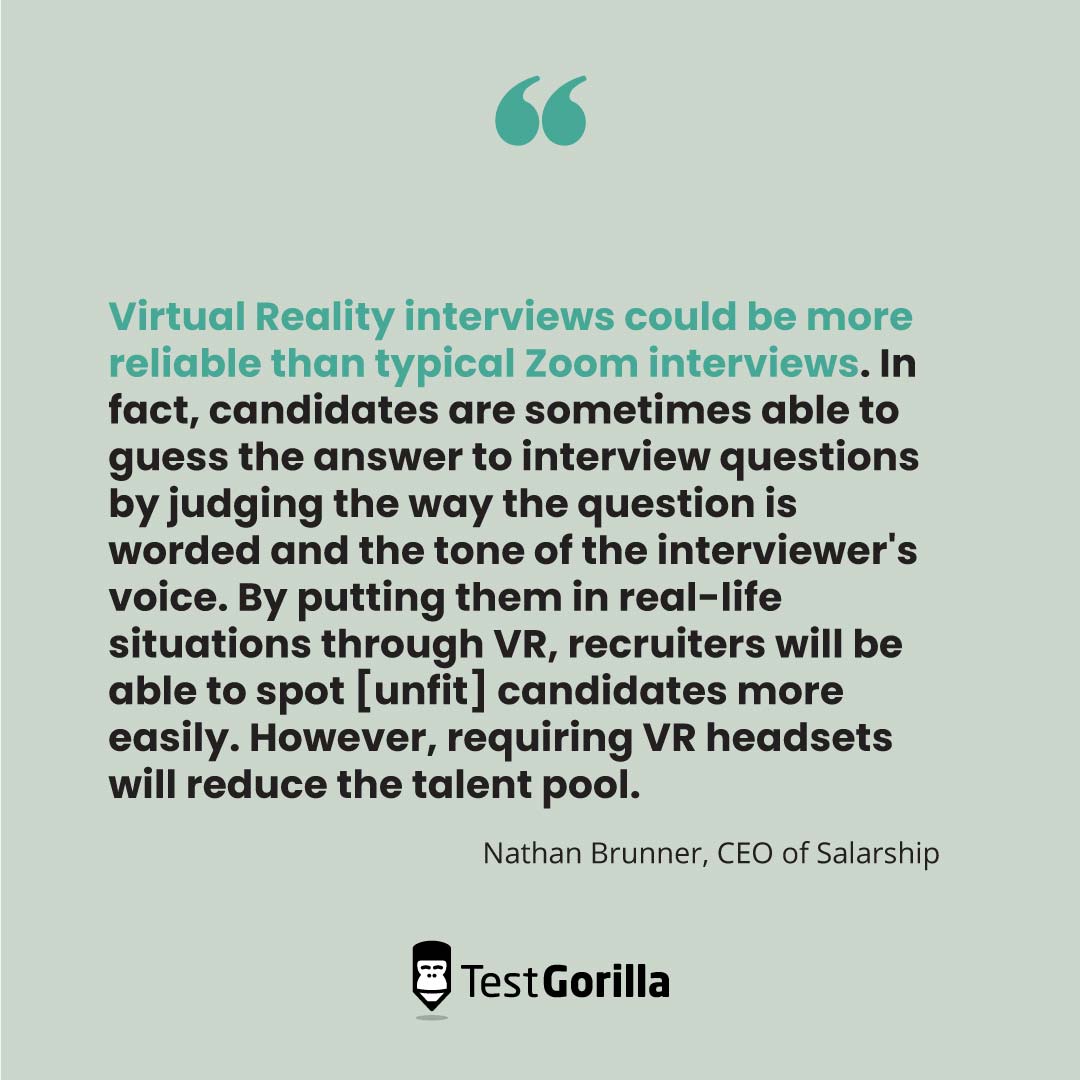Using the metaverse, or virtual reality (VR), for recruitment is a hot topic. On the one hand, if video calls work fine, then why complicate things? On the other hand, the metaverse can facilitate interactions with candidates in new and exciting ways. It could also make the recruiting world accessible to a more diverse talent pool.
This new technology is at a crucial point in its development. The metaverse is on the brink of taking remote hiring practices to a new level that will enrich the candidate experience.
It could also offer a bias-free applicant experience that will go down well with Gen Z and Gen Alpha, complement skills-based hiring, and enhance remote hiring and diversity.
There are some challenges to consider, however. For example, you need to set up advanced digital technologies and hardware, which may put the metaverse out of reach of some companies or candidates.
In this piece, we’ll look at the potential applications of the metaverse for hiring. We’ll also review how some larger companies have taken to this new practice and the challenges they face.
The benefits of using the metaverse
The metaverse is a virtual world that lets users interact with each other and digital objects in a shared, online space. It aims to integrate physical and digital worlds where people can move between different platforms and devices using personalized avatars.
This technology has already gained momentum in the gaming and fashion industries, where it’s used to organize in-game hangouts and virtual catwalks. It’s also increasingly used in education, retail, and entertainment. For example, in April 2020, American rapper Travis Scott performed in the metaverse for an audience of 12.3 million people.
The metaverse also has the potential to transform the way organizations approach recruitment.
Companies like Hyundai and Samsung hosted career fairs in the metaverse in 2020 and 2021.[1] [2] PwC UK launched their Virtual Park metaverse platform in September 2020, welcoming thousands of students from across the UK and worldwide to their recruitment event. All students needed to do was download the software, create an avatar, and enter the space.[3]
PwC delivered an interactive virtual recruitment experience to students from around the world – no Virtual Reality (VR) headset required. Source: PwC UK
Let’s take a look at how using the metaverse for recruitment can benefit your company and candidates.
1. Improves the candidate experience
The metaverse has the potential to enhance the candidate experience by giving people a more immersive and engaging way to interact with potential employers.
Virtual job fairs and interviews allow candidates to learn about the company culture and work environment in a more interactive and dynamic way. These virtual events also create more opportunities for interaction with potential colleagues or managers, which can help candidates make more informed decisions.
The metaverse also gives you a unique platform to showcase your company’s culture and values through virtual environments that reflect your organization’s identity. For example, when Salesforce wanted a fun location for their virtual recruiting session in 2020, they decided to set it on the moon.
Finally, you can create personalized experiences for candidates, tailored to their interests and preferences. Let’s say a job seeker is interested in a particular area of your company. You can design an avatar to direct them to a virtual environment that showcases that department or function in more detail. At in-person events, this would be much more difficult to accomplish and coordinate.
2. Creates a more accessible, unbiased hiring process
Virtual job fairs and interviews in the metaverse offer more flexibility than traditional in-person events. That’s because candidates can participate from anywhere in the world when it’s convenient for them.
This is particularly beneficial for:
People with disabilities or limited mobility who can’t travel
Individuals who aren’t able to travel due to the difficulties of obtaining a visa, etc.
Neurodiverse professionals who may normally be screened out due to a lack of neuroinclusive work practices and how their neurodiversity presents in the workplace.
Reducing bias during hiring helps you create a more inclusive recruitment process, which opens your doors to more diverse talent and leads to a more innovative, versatile workforce.
Hiring through the metaverse can also make the process fairer and less biased. It does this by reducing the impact of physical appearance, age, race, and other factors that may introduce discrimination in the hiring process. That’s because users in the metaverse are free to design their avatars to look however they want – they can even be non-human.
By using the metaverse, you can focus on the skills, qualifications, and personality of the candidates, rather than what they look like. This helps you find the best fit for their organizations while making the process more equitable.
3. Makes you more attractive to younger candidates
The metaverse’s flexibility and advanced technology appeal to digital-native generations like Z and Alpha who look for innovative and engaging ways to showcase their skills and personalities online (more on this below).
A 2022 Microsoft study found that 51% of Gen Z envision doing some of their work in the metaverse in the next two years.[4]
Taking advantage of virtual hiring opportunities can be a great way to motivate Gen Z workers to apply – and maintain your competitiveness in the labor market. Gen Alpha will make up 11% of the workforce by 2030, so being open to this innovative hiring practice can help you welcome young people with the digital skills your company needs to survive.[5]
Gen Z and Gen Alpha are already hanging out in the metaverse – socializing, playing games, and attending concerts. By leveraging the metaverse for hiring, you can also showcase your innovative, tech-forward culture and meet the younger generations where they are.
4. Allows candidates to showcase skills
Holding interviews in the metaverse lets candidates showcase their talents and abilities in new and engaging ways. For example, by creating immersive portfolios, simulations, or games.
By building digital avatars that can interact with virtual environments and digital objects, candidates can go beyond their resumes or cover letters. For example, a software developer could create a virtual demonstration to illustrate their programming skills in a more interactive, realistic way than a traditional, static resume.
Digital simulations and assessments provide a standardized evaluation of candidates’ abilities, reducing the potential for biases or errors in the hiring process. This paves the way for high-tech skills-based hiring that levels the playing field and helps you hire the best people for the role.
Finally, by building a virtual environment that simulates real-world challenges or scenarios, you can give your candidates a realistic job preview. This helps them make the right decision, reduces any surprises post-hiring, and makes it more likely that they’ll be happy in their new role. This has a positive knock-on effect on retention rates and reduced turnover.
“Virtual Reality interviews could be more reliable than typical Zoom interviews. In fact, candidates are sometimes able to guess the answer to interview questions by judging the way the question is worded and the tone of the interviewer’s voice. By putting them in real-life situations through VR, recruiters will be able to spot [unfit] candidates more easily. However, requiring VR headsets will reduce the talent pool.”
Nathan Brunner, CEO of Salarship
The challenges of using the metaverse for hiring
The metaverse has the potential to improve and complement your current hiring practices. However, it’s not without its challenges. Let’s take a look at what some of those are.
1. Limited access to technology
While more and more companies are adopting VR and the metaverse, it’s still out of reach for many job seekers and organizations, which may limit uptake.
For companies, it requires a significant investment in hardware, software, training, and hiring metaverse experts. Even after implementing the technology, you may need to continue investing in updates and maintenance to ensure a seamless experience for candidates and recruiters.
Similarly, while you don’t necessarily need a VR headset to join the metaverse, the experience is highly limited and not as immersive on a smartphone or computer. But requiring VR headsets from candidates can significantly limit your applicant pool to only those with the means to afford them.
Specifically, it can put those from underserved communities or experiencing digital poverty at a disadvantage. This is because not everyone has access to the advanced, often costly tech to fully participate in a virtual recruitment process.
Another challenge is the lack of standardization and interoperability between different metaverse platforms and devices. If you and your candidates are using different software or hardware, you may not be able to access or experience the same virtual environment or features. This can create compatibility issues and communication barriers for some and favor others.
To reduce this risk, you need to take extra care and create a consistent and inclusive hiring process in the metaverse that respects the tech your potential talent pool has. Be mindful of the potential for bias and unequal access – and support candidates who may be at a disadvantage.
This could mean offering alternative ways to participate such as in-person or through online meetings. You could even explore ways to make the technology more accessible, like partnering with technology providers or investing in new solutions that are more affordable and easier to implement.
2. Could exclude older candidates
The metaverse can create barriers for older candidates who aren’t familiar with VR technology. This can make it more difficult for them to navigate the recruitment process and accurately express their personality and skills. This is particularly problematic given that ageism in hiring is already a concern for many companies.
If you rely too heavily on virtual environments and tech-forward hiring methods, you risk alienating older employees and losing out on their decades of valuable experience.
Also, keep in mind that technical skills aren’t necessarily a reflection of a person’s overall qualifications or potential.
Instead of avoiding metaverse-based recruitment entirely, take some steps to ensure that all candidates, regardless of age or technical proficiency, have equal access to opportunities.
For example, you can offer online and in-person training and support to help people become more comfortable with the technology, including micro-learning courses to make this education more accessible.
Looking for more actionable tips for supporting older workers? Check out our guide to 7 best practices for making older people part of your D&I strategy.
3. Privacy issues
As a relatively new and unregulated technology, the metaverse can pose significant risks to data security and personal privacy for both candidates and companies.
Companies run the risk of exposing sensitive information about their business strategies, products, and intellectual property to hackers or competitors. For example, if you conduct a virtual interview in the metaverse, you might inadvertently reveal confidential information that can be intercepted or recorded by unauthorized parties.
Additionally, you might face legal liabilities if your company fails to comply with your country’s data protection regulations or ethical standards when collecting and processing personal data from candidates in the metaverse.
Employees and candidates may also lose control of their personal data and digital assets that are stored or generated in the metaverse. For example, they might not be able to delete or modify their online profiles, avatars, or content themselves. Depending on the platform’s permissions, they might need the platform administrator or a third-party provider to do it for them.
The best insights on HR and recruitment, delivered to your inbox.
Biweekly updates. No spam. Unsubscribe any time.
The metaverse for hiring: An evolving landscape with great horizons
The metaverse is still a new world but it’s already starting to impact the future of work. The jury’s still out on exactly what this will look like, but we know it can have many benefits for companies, HR professionals, and candidates alike.
Using the metaverse for hiring can introduce a more engaging candidate experience, create a less biased recruitment process, and make you more attractive to younger job seekers.
On the other hand, the technology that’s needed to fully participate in the metaverse is still costly and out of reach for most people and companies. This means you need to approach it with caution to avoid limiting your applicant pool and excluding talented professionals. It’s also not without its privacy issues, so you need to take extra steps to protect company, employee, and candidate data.
As the metaverse becomes more integrated into our daily lives, companies that embrace this technology may have a competitive advantage in attracting and retaining top talent.
When you combine tech-forward practices with a skills-based approach to hiring, you help individuals from a wide range of backgrounds, experiences, and identities to showcase their abilities and succeed in the role. This ensures you’re building a more inclusive, capable workplace while saving time and resources, and streamlining hiring efforts.
Want a fairer way to hire top talent while you wait for the metaverse to become accessible?Skills-based hiring can help you build happier, more future-proof teams from a wider talent pool. Download the 2022 State of Skills-Based Hiring report to learn more
Sources
“New Employees, Come to Metaverse.” Hyundai MOBIS. Accessed May 5, 2023. https://www.hyundaimotorgroup.com/story/CONT0000000000001842
“Samsung Biologics hosts its first metaverse Job Fair.” Samsung Biologics. Accessed May 5, 2023. https://samsungbiologics.com/media/company-news-view?boardSeq=1642
“Virtual reality recruitment.” PwC. Accessed May 5, 2023. https://www.pwc.co.uk/who-we-are/annual-report/stories/2021/virtual-reality-recruitment.html
“Great Expectations: Make Hybrid Work Work.” Microsoft. Accessed May 5, 2023. https://www.microsoft.com/en-us/worklab/work-trend-index/great-expectations-making-hybrid-work-work
“Welcome to Generation Alpha: Definitions, stats, predictions.” The Future of Commerce. Accessed May 5, 2023. https://www.the-future-of-commerce.com/2022/08/09/generation-alpha-definition-stats-predictions/
Related posts
You've scrolled this far
Why not try TestGorilla for free, and see what happens when you put skills first.

















